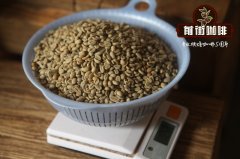Honduras coffee beans varieties introduced? Honduras Cadura Cadua Coffee Bean Flavor and Mouth

Professional coffee knowledge exchange more coffee bean information please follow the coffee workshop (Wechat official account cafe_style)
Introduction to the varieties of coffee beans in Honduras? Flavor and taste characteristics of coffee beans in Kadulakaduai, Honduras?
Coffee has been grown in Honduras for more than 200 years (it began in 1804). There are 280000 hectares of coffee gardens in the country, mainly small coffee traders, most of which are less than 3.5 hectares, which account for 60% of Hongguo's production. In the coffee garden, men and women collect coffee beans by hand, then carefully handle and process them to meet the needs of the market and meet the different tastes of consumers. Honduras collects 3 million bags of coffee every year, providing the world with perfect coffee, unique coffee aroma and multi-quality, making it the second largest coffee exporter in Central America and the tenth largest coffee exporter in the world. Hongguo's coffee industry has a bearing on the livelihood of 100,000 families in Hongguo, creates 1 million jobs and creates a permanent economic foundation for Honduras.
Honduran coffee is divided into six major producing areas, spread all over the west and south, namely Santa Barbara (Santa Barbara), Periso (El Paraiso), Copan (Copan), La Paz (La Paz) and Comayagua (Olan Mound), with an average height of more than 1100 meters above sea level. Coffee varieties are 100 per cent Arabica, 69 per cent are HG and 12 per cent are SHG,19% and CS. There are mainly Typica, Bourbon, Caturra, Villa Sarchi and Lempira brands. Hongguo coffee is of first-class quality and its price is the most competitive in Central American countries.
Small, round, slightly bluish green coffee, high acidity, full and slightly sweet taste, suitable for comprehensive coffee, can also be made into single coffee, suitable for medium and deep roasting, mainly exported to the United States, Germany and Japan.
According to statistics, the planting area now reaches 280000 hectares, all of which are mainly small coffee farmers. 92% of Honduran coffee farmers are small individuals, and most of their coffee plantations are less than 3.5 hectares. These small coffee farmers account for 60% of coffee production! Coffee is a very important crop in Honduras.
In the coffee garden, coffee farmers harvest red fruits, wash and ferment them and grade them according to the needs of the market to meet the different tastes of consumers. Honduras collects 3 million bags of coffee every year, supplying good quality coffee and unique coffee flavor, large quantity and high quality! Now it has become the largest producer in Central America and the top ten coffee exporters in the world.
With a sweet smell of lemon, smooth surface and sour taste, you can brew a cup of coffee that tastes good.
Coffee beans feature:
The quality of our coffee is directly combined with the geographical characteristics of the country of origin, as well as the rigorous and painstaking process of producers from farm production, processing, drying, baking, packaging to sales preparation. Most of the products are moderately roasted, and moderately roasted coffee is moderately brown and brighter than lightly roasted coffee. Like lightly roasted coffee, there is no oil on the surface of coffee beans. However, moderately roasted coffee will not have the grassy flavor of lightly roasted coffee, but will show a more balanced flavor, aroma and acidity.
Coffee bean attributes:
Variety: Kaddura / Kaduai
Kaduai raw beans are relatively soft, sweet and sweet, sour less, as if everything is only 65 points, this is a variety promoted by Brazil, there is no big deal at present.
Kaduai is also an Arabica hybrid. It is a hybrid of Mundo Novo Mondonovo (New World) and Caturra Kaddura. It has a good ability to resist natural disasters, especially wind and rain. It inherits the advantages of Kaddura's low stature and changes Mondonwood's shortcomings. Another advantage is that the result is solid, and it is not easy to fall off when the strong wind blows, which makes up for the weakness of Arabica fruit, but the overall flavor is more monotonous than Kaddura, monotonous and less mellow, which is the greatest pity. In addition, the fruit growth and harvest life is only about ten years, and the short life span is also one of the weaknesses.
Kaduai also has the difference between Catuai Amerelo and Catuai Vermelho. The fruit is both red and yellow, but so far, no yellow fruit has been found to taste better than red fruit. On the contrary, some people have found that some yellow fruits have good acidity, but the cleanliness of coffee is worse than that of red fruit. Statistically, Hongguo Kaduai often wins prizes.
Because Kaddura has a large quantity and is not easy to suffer from diseases and insect pests, but the taste is not good and the flavor is not good, so based on Kaddura, a new Kaduai is derived to improve the disadvantage of poor taste and poor flavor, but it seems to be too balanced.
Flavor: with sweet smell of lemon, smooth surface and sour taste, you can brew a cup of coffee that tastes good.
Producing area: El Paraiso province
Altitude: 1000-1400 m
Annual rainfall: 950mm-1500 mm
Temperature: 16-22.5 degrees C
Important Notice :
前街咖啡 FrontStreet Coffee has moved to new addredd:
FrontStreet Coffee Address: 315,Donghua East Road,GuangZhou
Tel:020 38364473
- Prev

Distribution of coffee producing areas in Honduras? Flavor and taste characteristics of coffee beans in coffee producing areas of Honduras
Coffee knowledge exchange more coffee bean information please follow the coffee workshop (Wechat official account cafe_style) the distribution of coffee producing areas in Honduras? What are the flavor and taste characteristics of coffee beans in the coffee producing area of Honduras? Honduras was previously less well-known in the consumer market because it did not have strong support for the handling and transportation of raw beans. In recent years, Hongguo has made a response to
- Next

Honduras Manor Coffee beans Tropical Rain Forest certified flavor of washed beans from SHG St. Vincent treatment Plant
Professional coffee knowledge exchange more coffee bean information please follow the coffee workshop (Wechat official account cafe_style) Honduran manor coffee beans tropical rain forest certified SHG St. Vincent processing plant Honduran water washed beans flavor and taste characteristics? Production area: Santa Barbara province (Santa Barbara) Pena Blanca town processing plant: St. Vincent processing plant (Beneficio)
Related
- Detailed explanation of Jadeite planting Land in Panamanian Jadeite Manor introduction to the grading system of Jadeite competitive bidding, Red bid, Green bid and Rose Summer
- Story of Coffee planting in Brenka region of Costa Rica Stonehenge Manor anaerobic heavy honey treatment of flavor mouth
- What's on the barrel of Blue Mountain Coffee beans?
- Can American coffee also pull flowers? How to use hot American style to pull out a good-looking pattern?
- Can you make a cold extract with coffee beans? What is the right proportion for cold-extracted coffee formula?
- Indonesian PWN Gold Mandrine Coffee Origin Features Flavor How to Chong? Mandolin coffee is American.
- A brief introduction to the flavor characteristics of Brazilian yellow bourbon coffee beans
- What is the effect of different water quality on the flavor of cold-extracted coffee? What kind of water is best for brewing coffee?
- Why do you think of Rose Summer whenever you mention Panamanian coffee?
- Introduction to the characteristics of authentic blue mountain coffee bean producing areas? What is the CIB Coffee Authority in Jamaica?

